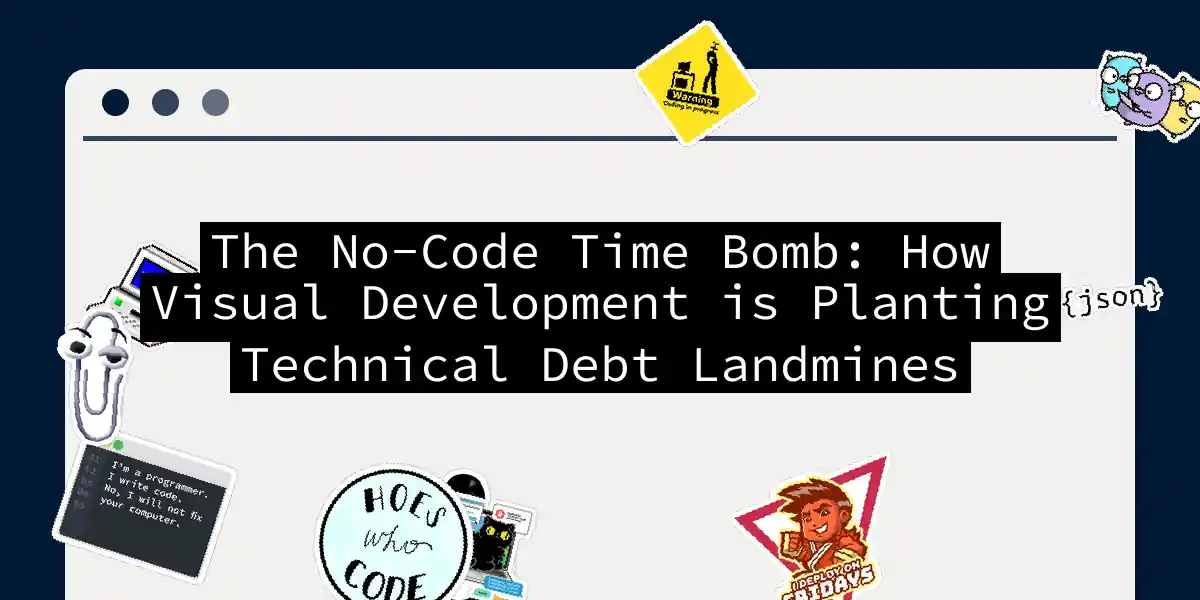Picture this: You’ve built a gorgeous application faster than a caffeinated squirrel hoarding acorns. No syntax errors, no merge conflicts, just pure drag-and-drop bliss. But lurking beneath those colorful blocks lies a hungry gremlin quietly gnawing at your project’s foundations. Welcome to the world of no-code technical debt - where today’s shortcut becomes tomorrow’s eight-hour debugging marathon.
When Visual Simplicity Breeds Hidden Complexity
Let’s dissect a real-world example from my consulting days. A client proudly showed me their “perfect” Airtable-powered inventory system:
{
"Base Structure": {
"Products": [
{
"SKU": "AUTO_NUMBER",
"Supplier": {"Linked": "Vendors"},
"Reorder Logic": "IF({Stock}<10, {Supplier.Email} & ' Urgent!')",
"Pricing History": "ROLLUP({Price Changes})"
}
],
"Vendors": [
{
"Contact": "LINKED_TO_GOOGLE_CONTACTS",
"Contract": "ATTACHMENT"
}
]
}
}
Looks clean? Here’s the technical debt cocktail:
- Spaghetti linkages: 12 layers of nested relationships
- Brittle automations: Email triggers without error handling
- Schema concrete: Impossible to migrate without breaking 47 dependencies Like a Jenga tower built during an earthquake, it worked until someone needed to swap out the “Supplier” relationship. Cue the 3 AM support calls.
The Invisible Tax of Drag-and-Drop Development
This vicious cycle burns more common than a TikTok dance challenge. The kicker? Unlike traditional code debt that’s visible in pull requests, no-code debt hides in:
- Unexported workflow histories
- Undocumented automations
- Platform-specific constraints (looking at you, 10k row limits) I recently audited a Bubble.io app that had more hidden conditional logic than a Tinder match’s bio. The original developer had left, and the team was terrified to touch anything - the digital equivalent of inheriting a haunted mansion.
Defusing the Bomb: Tactical Debt Management
- The Autopsy Approach
- Export and diagram critical workflows weekly
- Use platform-native versioning like Airtable’s revision history
- Implement naming conventions (prefix automations with [CRITICAL], [DEPRECATED])
- The Containment Strategygraph LR A[Legacy Workflow] --> B(Wrapper Interface) B --> C[New Implementation] C --> D{Validated?} D -->|Yes| E[Gradual Migration] D -->|No| F[Rollback Safe Zone]Create abstraction layers before refactoring, like wrapping legacy automations in validation checkpoints
- Debt Prevention Protocol
- Enforce “documentation sprints” every 200 automation changes
- Implement cross-training requirements: At least two team members must understand critical flows
- Use platform-specific linters (e.g., Airtable Metadata Scraper, Make.com Audit Tools)
The Maintenance Mindset Revolution
Technical debt in no-code isn’t about bad tools - it’s about believing the marketing pixie dust that claims these systems never need maintenance. The reality? That shiny no-code app has more in common with a Tamagotchi than a stone tablet. It needs feeding (updates), cleaning (refactoring), and occasional trips to the digital vet (performance tuning). Here’s my battle-tested maintenance checklist:
- Weekly: Audit automation error logs
- Monthly: Test backup restore process
- Quarterly: Document walkthrough videos
- Biannually: Platform limitation review (did Bubble just change their pricing tier limits again?) The no-code revolution isn’t going anywhere, but neither is entropy. By treating visual development with the same rigor as traditional programming, we can build systems that survive past the next feature request tsunami. After all, even digital castles need moats - even if they’re made of flowcharts instead of code.
